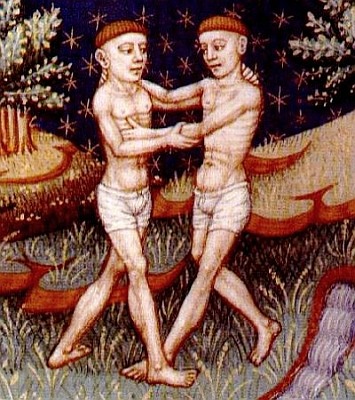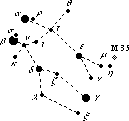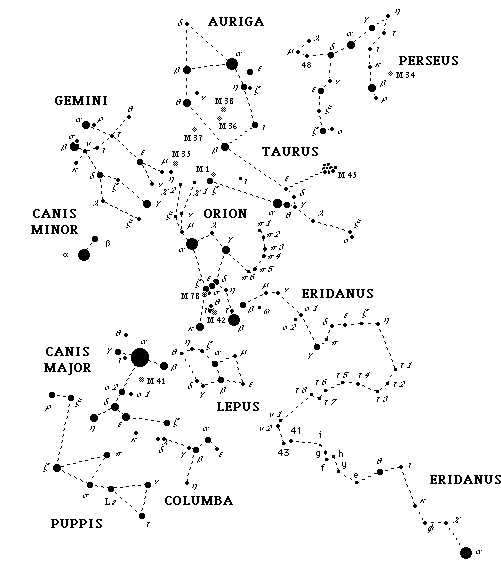|

The constellation of Gemini is symbolized by twins. To the people of
Mesopotamia, they were known as Meshlamtaea -- "'The One Who has
Arisen from the Underworld" -- and Lugalirra --
"Mighty King." The allusions to Christ are evident in those ancient
names, but the Greeks named the Twins -- the Dioskouroi -- Kastor and
Polydeuces, Latinized to Castor and Pollux, and the two brightest stars
of this constellation are named for them as well. It's fascinating that
the Greco-Roman myths about Castor and Pollux relate that Pollux was
immortal, the son of Zeus, who took on the form of a swan to seduce
Leda, the boys' mother. Castor was mortal, the son of Leda and her
husband. When Castor was dying, the immortal Pollux was given the
choice, by Zeus, to give to Castor some of his immortality, and this he
chose to do, just as Lord Christ offers us His immortality if we
receive His grace.
The sign of Gemini refers to unity, to the marriage of the lamb as
foretold by Capricornus and written
about in the Apocalypse of St. John
19:7-9:
Let us be glad
and rejoice, and give glory to Him; for the marriage of the Lamb is
come, and His wife hath prepared herself. And it is granted to her that
she should clothe herself with fine linen, glittering and white. For
the fine linen are the justifications of saints. And he said to me:
Write: Blessed are they that are called to the marriage supper of the
Lamb. And he saith to me: These words of God are true.
We will become One with Him, partakers of the Divine Nature,
destined to be with Him forever and forever. All of our hearts'
longings will be fulfilled. Everything we've suffered, everything we've
sacrificed, the almost existential loneliness of being human, that
sense of not being completely "filled," not being completely who we are
supposed to be -- all is fulfilled in our Communion with Him, and this
marriage lasts for eternity. But those who say no to Him will have
a
different fate, as the Sign of Cancer will tell us.
Note: On the Feast of St. Lucy,
December 13, one of the greatest meteor showers of the year, the
Geminids, may be seen emanating from Gemini. Note, too, that the Twins
are mentioned in Acts 28:11: "And after three months, we sailed in a
ship of Alexandria, that had wintered in the island, whose sign was the
Castors." Castor and Pollux were patrons of sailors to the Greeks, and
St. Paul sailed on a ship that had the Twins as its sign.
Decan One: Lepus
When thinking of Lepus, the Hare, we have to get past our common -- and
understandable -- associations of the animal with fertility and
unmitigated cuteness. We have to go back to our roots as people tied to
the land, people for whom the hare was an enemy, the destroyer of
crops, an animal that threatened our very livelihood. The word "hare"
has ties to the words "harass," which comes from the German "hare," a
cry urging dogs to attack. This entered the French language as
"harasser," "to set a dog on."
Considering that aforementioned cuteness of the hare is important when
remembering the attractiveness of evil. Evil gets done because people
are attracted to it. They want
to engage in it. Satan was once the most beautiful cherub, and he knows
how to appeal to our most basic desires. He appeals
to us by promising the satisfying of lust, wordly treasure, the glitter
of fame that causes some to sell their very souls to the Evil One (see
the page on Oppression, Obsession,
and Possession in The
Preternatural World section of this site). In II Corinthians 11:14,
St. Paul tells us that "Satan himself transformeth himself into an
angel of light." But to give in to evil
is to risk burning in Hell forever, the fate of many, as we'll see with
our next Zodiacal constellation, the sign of Cancer.
Decan Two: Canis
Major
Defending us from the Hare are the two dogs -- Canis Major and Canis
Minor -- of the Second and Third
decans of Gemini. These dogs belong to Orion the Hunter, the first
decan of Taurus, and symbol of Christ. He
has yelled "hare!" to His
dogs, and they've set
to work to protect us from evil as represented by Lepus. Canis Major
contains the very
brightest-appearing star in the night sky, Sirius, a.k.a. "the Dog
Star," which can be found by locating the three stars that make up
Orion's belt, and moving your eyes downward, following the angle of the
belt's tilt, to a distance equal to
about eight widths of that belt. It will be the brightest object you
see.
Decan Three: Canis
Minor
See Canis Major above. And make note
of the light yellowish-white star, Procyon, in this constellation. This
star,
the sixth
brightest in the Northern Hemisphere gets its name, which means
"Before the Dog", due to its preceding Sirius, the Dog Star, as they
make their way across the Winter sky.
That Canis Major
and Canis Minor are two in number is
interesting, especially given that one is "The Great Dog" and the other
"The
Lesser Dog." Perhaps they can be considered as symbolizing the Two
Great Commandments, given to us in the Gospel of St. Matthew 22:36-40:
Master, which is
the greatest commandment in the law?
Jesus said to him: Thou shalt love the Lord thy God with thy whole
heart, and with thy whole soul, and with thy whole mind. This is the
greatest and the first commandment.
And the second is like to this: Thou shalt love thy neighbour as
thyself. On these two commandments dependeth the whole law and the
prophets.
With dogs being symbols of fidelity, we can see these two
great stellar dogs as reminders to be faithful to what God commands so
we can partake of the marriage feast and avoid the fate of those who
refuse His grace, about whom we'll read with the Sign of Cancer.
[Note that three stars -- Orion's Betelgeuse, Canis Major's Sirius,
and Canis Minor's Procyon -- together form an equilateral triangle
known
as "the Winter Triangle."]
Gemini can be
seen between November and April. Pollux is to the south-left; Castor is
to the north-right. The stars that make up the stick figures' heads are
named after them -- Pollux and Castor. Pollux and Castor are the
twelfth and sixteenth brightest stars of the Northern hemisphere,
respectively.


Gemini relative
to other stars in the Winter sky:

|
|

![]()
